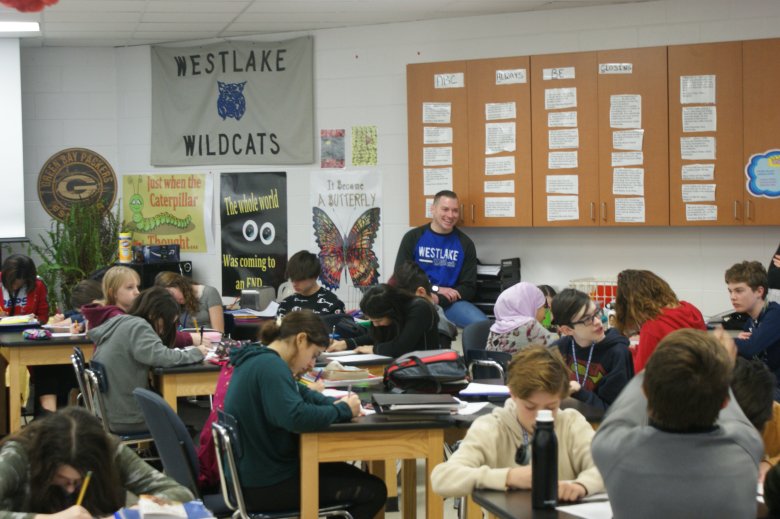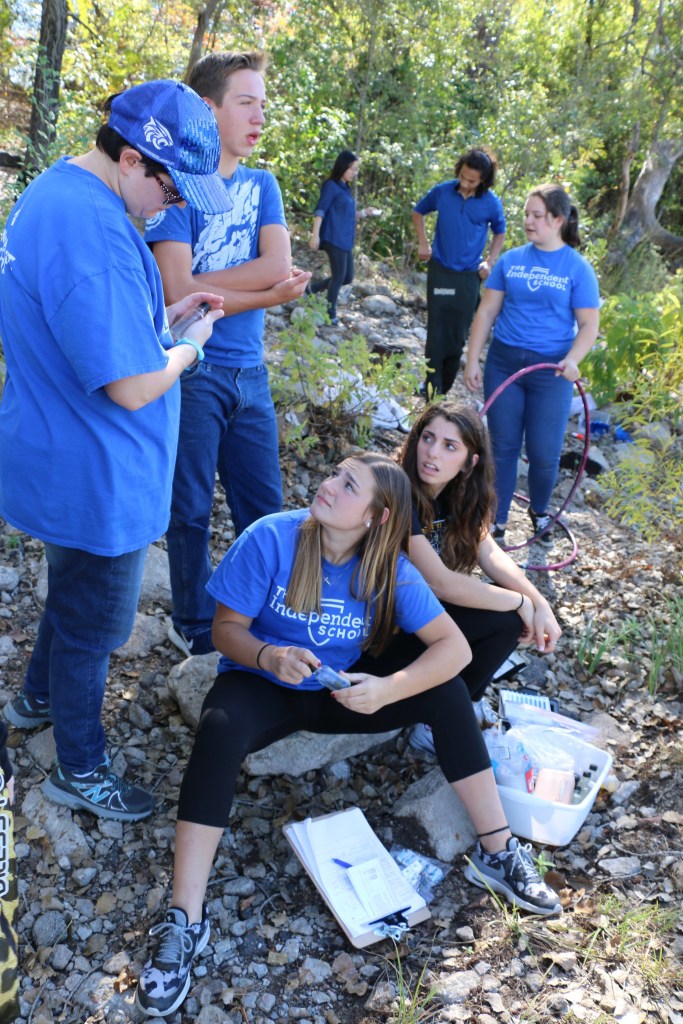This story was produced as part of the nine-part series “Are We Ready? How Schools Are Preparing – and Not Preparing – Children for Climate Change,” reported by HuffPost and The Hechinger Report, a nonprofit, independent news organization focused on inequality and innovation in education.
When Rebecca Brewer started teaching high school biology 20 years ago, it seemed like everyone trusted science. Teaching topics like the science of vaccinations elicited little controversy. But in the past few years, she’s seen a shift. Now, every year, she reliably has a few students who push back against the topic.

“Their parents’ opinions make their way into the classroom,” said Brewer, who teaches in Troy, Michigan. “Of course some students will bring up the idea they’ve heard that there’s a connection between vaccinations and autism.”
The issue, teachers said, feels not only especially urgent now, but also comes with increasingly high stakes: In a recent Yahoo News/YouGov poll, nearly 20 percent of respondents said they wouldn’t get a coronavirus vaccine if and when it becomes available. It’s an attitude that some teachers said is reflected in their classrooms, passed down to students from their parents at early ages.
Are We Ready?
This nine-part series explores how we’re teaching through climate change. We report on how climate change emergencies are disrupting student learning, exacerbating mental health problems, devastating school infrastructure, and how the coronavirus pandemic is a preview of what education looks like in a climate emergency. We also look at how textbooks are coming up short in teaching kids about climate, how medical schools are preparing future doctors, and how despite the obstacles some educators are finding ways to give students skills they need to better protect themselves and their communities.
“A lot of time they haven’t thought in-depth, they’re teenagers, it’s more so their parents’ decisions … there’s still time we can intervene as science teachers and let them see the evidence and come to their own conclusion,” said Brewer.
Science teachers often receive little guidance on teaching the science of vaccines — the topic is not mentioned in the Next Generation Science Standards (NGSS), the national science teaching standards that have been adopted in 20 states and influenced the standards in 24 others. At the same time, in recent years, confidence in the science of vaccinations has been trending downward — one recent survey shows that the percentage of American adults reporting it is “very important” to have their children vaccinated dropped 11 points between 2008 and 2018.
When discussing vaccines, some teachers report having to steer through murky waters. They report having to seek out their own teaching resources on the issue while navigating the uncomfortable space of presenting facts that their students’ families may deeply disagree with.
In a recent Yahoo News/YouGov poll, nearly 20 percent of respondents said they wouldn’t get a coronavirus vaccine if and when it becomes available.
Brewer uses case studies to teach the science of vaccines; last year she used the example of a 2015 measles outbreak linked to Disneyland. While the NGSS doesn’t specifically say teachers should teach about vaccines, it’s an issue her district has decided to emphasize.
The NGSS was released in 2013. Prior to that, states followed their own unique standards, sometimes causing substantial differences between curriculum across state lines. The new standards emphasize scientific inquiry and critical thinking over recitation of facts. While many educators say they prefer that approach to older methods of science instruction, use of the standards sometimes means that teachers cover fewer topics as they delve more deeply into those that are discussed.
Heidi Schweingruber, who co-directed the study that resulted in the framework on which NGSS was based, said it offers educators guidance on the big ideas in science. Viruses and vaccines “in terms of grain size” did not necessarily rise as something to highlight at that level. But she said the standards and framework are “living documents” and that viruses and vaccines might be part of discussions on revising the standards.

Brewer hopes that after the coronavirus pandemic subsides, there might be a shift in thinking on the topic. She wondered if, maybe then, the standards will be revised in a way that signal “of course this is something the general public needs to understand well.”
Coronavirus as a teachable moment
While viruses and vaccines aren’t mentioned explicitly in the NGSS, educators said the subjects are a natural fit for the overarching approach called for in the standards: investigating the world through scientific questions and evidence. And topics that are listed in the standards, like DNA, lend themselves to teaching about vaccines, said Mike Fumagalli, principal at Glenn Westlake Middle School in Illinois and a former high school biology teacher.
Kristin Rademaker, an instructional facilitator at the middle school and a science consultant, said that over the years she has heard kids speculate on the safety of vaccines and even debate each other on the topic. In her district, she recommends that teachers focus on how vaccines work in the context of animals, instead of humans, pointing to such examples as how vaccinating cattle afflicted with a disease called Rinderpest helped save not only the lives of the cattle, but also thousands of the wildebeest and buffalo of the Serengeti, who suffered the disease as a “spillover species.” Distancing the science of vaccination from its use in people helps even skeptical students understand the science.
Other teachers tackle the controversy head-on. Lin Andrews, who taught biology for 18 years in Kansas public and private schools, said she would cite the (now-retracted) paper suggesting a link between autism and the MMR vaccine in order to show students how bias and poor data can creep into the scientific process. “By putting the conversation in this context I rarely encountered pushback from parents or students,” said Andrews, who now serves as director of teacher support at the nonprofit National Center for Science Education. She said timely and even controversial topics can help ignite students’ interest, and she’s currently developing a lesson plan on the “nature of science” that will use the coronavirus as the main theme.

Some teachers rely on resources from the Vaccine Makers Project, a program out of the Vaccine Education Center at the Children’s Hospital of Philadelphia. The nonprofit project provides materials for teachers to use free of charge. Charlotte Moser, assistant director of the Vaccine Education Center, said staff at the center created the project about five years ago, after seeing a need in the classroom for additional tools. While vaccines are not covered in the NGSS, Moser said she sees a lot of educators — especially those involved in biology and Advanced Placement courses — teaching about them.
The current pandemic provides a special teachable moment for students and educators.
“A lot of time they haven’t thought in-depth, they’re teenagers, it’s more so their parents’ decisions … there’s still time we can intervene as science teachers and let them see the evidence and come to their own conclusion.” Rebecca Brewer, science teacher, Troy, Michigan
Kate Cilluffo teaches biology in Edison, New Jersey, and relies in-part on the Vaccine Makers Project for materials, in addition to making her own and using resources from the CDC. Prior to joining the district, she pursued a PhD in immunology. She’s currently teaching students about the mutation of viruses and how that relates to vaccines. She surveyed her students on whether they would want to learn right now about the coronavirus or the flu; 75 percent of students voted for the coronavirus. Now, she’s teaching most of her students about vaccines over video through the lens of the pandemic.
The students are overflowing with questions about when society will reopen, what happens if the virus mutates and what’s going to happen next year. Cilluffo works to update her lessons in real time as new information comes out. She has brought in experts and epidemiologists to chat with her students over video conferences.
She knows some teachers are trying to stay away from coronavirus-related topics right now, for fear it could overwhelm students. But she’s seen a real hunger for information in her classroom.
“I tell them that’s how real science works — so much is unknown. When you’re teaching something and you know the answer, it’s not as fun. When you’re teaching something and you don’t know the end result, it feels like real science,” said Cilluffo. “They get to act like scientists and ask the questions.”
The perils of parental pushback
All 50 states require that students receive vaccinations before starting school. However, 45 states and Washington, D.C., allow for exemptions based on religious beliefs. Fifteen states go a step further, allowing for philosophical exemptions, which means families can forgo immunizations based on moral or personal beliefs.
Minnesota, where 10th grade biology teacher Alison Wood works, is a philosophical exemption state.* Some parents in her district have been open about their skepticism to her lessons. Some have explicitly told her about their decision not to vaccinate their children.
During parent-teacher conferences, she recalled, one parent recommended that Wood watch the movie “Vaxxed: From Cover-Up to Catastrophe.” (In 2019, Amazon removed the film from its offerings following criticism from Rep. Adam Schiff (D-Ca.) that it pushes misleading science linking vaccines to autism.)
“Usually kids are just repeating what they hear at home; I very rarely hear a kid have their own unique objection.”
Alison Wood, science teacher, Duluth, Minnesota
Wood, who has taken a graduate-level course on the science of virology, watched the movie. She has sought to understand parents’ fears, and why they may be so quick to dismiss the science of vaccinations. The research has helped her understand their decisions and also provided her with a framework of how she can work to change minds.
“They really believe they’re in the right and they’re protecting their kid, and I have to believe they’re smart people they’re not making this up to be a pain,” said Wood, who teaches in the city of Duluth.
Wood teaches about vaccines, with an emphasis on community health, during units on the immune system and basic cell biology. The Minnesota state science standards specifically call out “vaccines” as one way to teach about immunity, she said. In class, she conducts a simulation to show the impact of community spread — a topic that feels particularly relevant now. She then pushes her students to go home and find out if they’ve been vaccinated — some students say they have no idea what their parents decided for them.
She also lets students know that they can get hepatitis B vaccines if they want, regardless of their parents’ beliefs. In Minnesota, minors can get the vaccination without parental consent.
“Usually kids are just repeating what they hear at home; I very rarely hear a kid have their own unique objection,” said Wood. A classroom teacher for almost 20 years, Wood said vaccination skepticism in her classroom usually comes in waves, depending on what’s been in the news of late. “I do bring this up to kids a lot: This is your choice at this point, you can help out if you are able to.”
*Correction: This version of the story has been updated with the correct spelling of Alison Wood’s first name.



